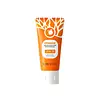What's inside
What's inside
 Key Ingredients
Key Ingredients

 Benefits
Benefits

 Concerns
Concerns

 Ingredients Side-by-side
Ingredients Side-by-side

Water
Skin ConditioningCarbomer
Emulsion StabilisingDipropylene Glycol
HumectantDodecylbenzyltrimonium Chloride
AntimicrobialPEG-40 Hydrogenated Castor Oil
EmulsifyingParfum
MaskingEthylhexylglycerin
Skin ConditioningLactose
HumectantCitrus Aurantium Dulcis Peel Oil
MaskingLactobacillus/Milk Ferment Filtrate
Skin ConditioningPseudoalteromonas Ferment Extract
HumectantBacillus
Skin ConditioningNiacinamide
Smoothing3-O-Ethyl Ascorbic Acid
Skin ConditioningGlutathione
Pearl Extract
AntioxidantSalicylic Acid
MaskingHamamelis Virginiana Water
AstringentGlycolic Acid
BufferingLactic Acid
BufferingSea Salt
AbrasiveJojoba Esters
EmollientTitanium Dioxide
Cosmetic ColorantTocopheryl Acetate
AntioxidantAscorbyl Palmitate
AntioxidantCarnosine
Skin ConditioningGlycyrrhiza Glabra Root
Skin ConditioningFolic Acid
Skin ConditioningCynanchum Atratum Extract
Skin ConditioningCeramide As
Skin ConditioningCeramide Ns
Skin ConditioningCeramide AP
Skin ConditioningCeramide EOP
Skin ConditioningSodium Hyaluronate
HumectantCellulose
AbsorbentMicrocrystalline Cellulose
AbsorbentCI 77891
Cosmetic ColorantCI 77499
Cosmetic ColorantMannitol
HumectantHydroxypropyl Methylcellulose
Emulsion StabilisingHydrogenated Lecithin
EmulsifyingZea Mays Starch
AbsorbentDisodium EDTA
Mica
Cosmetic ColorantEthylcellulose
PEG-150
HumectantCI 77492
Cosmetic ColorantAcrylates/C10-30 Alkyl Acrylate Crosspolymer
Emulsion StabilisingPhenoxyethanol
PreservativeButylene Glycol
Humectant1,2-Hexanediol
Skin ConditioningMethylparaben
PreservativeCaprylyl Glycol
EmollientGlycerin
HumectantPentylene Glycol
Skin ConditioningWater, Carbomer, Dipropylene Glycol, Dodecylbenzyltrimonium Chloride, PEG-40 Hydrogenated Castor Oil, Parfum, Ethylhexylglycerin, Lactose, Citrus Aurantium Dulcis Peel Oil, Lactobacillus/Milk Ferment Filtrate, Pseudoalteromonas Ferment Extract, Bacillus, Niacinamide, 3-O-Ethyl Ascorbic Acid, Glutathione, Pearl Extract, Salicylic Acid, Hamamelis Virginiana Water, Glycolic Acid, Lactic Acid, Sea Salt, Jojoba Esters, Titanium Dioxide, Tocopheryl Acetate, Ascorbyl Palmitate, Carnosine, Glycyrrhiza Glabra Root, Folic Acid, Cynanchum Atratum Extract, Ceramide As, Ceramide Ns, Ceramide AP, Ceramide EOP, Sodium Hyaluronate, Cellulose, Microcrystalline Cellulose, CI 77891, CI 77499, Mannitol, Hydroxypropyl Methylcellulose, Hydrogenated Lecithin, Zea Mays Starch, Disodium EDTA, Mica, Ethylcellulose, PEG-150, CI 77492, Acrylates/C10-30 Alkyl Acrylate Crosspolymer, Phenoxyethanol, Butylene Glycol, 1,2-Hexanediol, Methylparaben, Caprylyl Glycol, Glycerin, Pentylene Glycol
Water
Skin ConditioningGlycerin
HumectantSodium Cocoyl Glycinate
CleansingSodium Lauroyl Glutamate
Sodium Methyl Cocoyl Taurate
CleansingButylene Glycol
HumectantGlyceryl Stearate
Emollient1,2-Hexanediol
Skin ConditioningSalicylic Acid
MaskingCitric Acid
BufferingDimethyl Sulfone
SolventMontmorillonite
AbsorbentIllite
AbrasiveDextrin
AbsorbentGardenia Florida Fruit Extract
Skin ConditioningMalic Acid
BufferingPyrus Malus Fruit Extract
Skin ConditioningWater, Glycerin, Sodium Cocoyl Glycinate, Sodium Lauroyl Glutamate, Sodium Methyl Cocoyl Taurate, Butylene Glycol, Glyceryl Stearate, 1,2-Hexanediol, Salicylic Acid, Citric Acid, Dimethyl Sulfone, Montmorillonite, Illite, Dextrin, Gardenia Florida Fruit Extract, Malic Acid, Pyrus Malus Fruit Extract
 Reviews
Reviews

Ingredients Explained
These ingredients are found in both products.
Ingredients higher up in an ingredient list are typically present in a larger amount.
1,2-Hexanediol is a synthetic liquid and another multi-functional powerhouse.
It is a:
- Humectant, drawing moisture into the skin
- Emollient, helping to soften skin
- Solvent, dispersing and stabilizing formulas
- Preservative booster, enhancing the antimicrobial activity of other preservatives
Butylene Glycol (or BG) is used within cosmetic products for a few different reasons:
Overall, Butylene Glycol is a safe and well-rounded ingredient that works well with other ingredients.
Though this ingredient works well with most skin types, some people with sensitive skin may experience a reaction such as allergic rashes, closed comedones, or itchiness.
Learn more about Butylene GlycolGlycerin is already naturally found in your skin. It helps moisturize and protect your skin.
A study from 2016 found glycerin to be more effective as a humectant than AHAs and hyaluronic acid.
As a humectant, it helps the skin stay hydrated by pulling moisture to your skin. The low molecular weight of glycerin allows it to pull moisture into the deeper layers of your skin.
Hydrated skin improves your skin barrier; Your skin barrier helps protect against irritants and bacteria.
Glycerin has also been found to have antimicrobial and antiviral properties. Due to these properties, glycerin is often used in wound and burn treatments.
In cosmetics, glycerin is usually derived from plants such as soybean or palm. However, it can also be sourced from animals, such as tallow or animal fat.
This ingredient is organic, colorless, odorless, and non-toxic.
Glycerin is the name for this ingredient in American English. British English uses Glycerol/Glycerine.
Learn more about GlycerinSalicylic Acid (also known as beta hydroxy acid or BHA) is a well-known ingredient for treating skin that struggles with acne and clogged pores. It exfoliates both the skin's surface and deep within the pores to help clear out buildup, control oil, and reduce inflammation.
Unlike AHAs (alpha hydroxy acids), salicylic acid is oil-soluble. This allows it to penetrate into pores which makes it especially effective for treating blackheads and preventing future breakouts.
Salicylic acid is also known for its soothing properties. It has a similar structure to aspirin and can calm inflamed or irritated skin, making it a good option for acne-prone skin that is also sensitive.
Concentrations of 0.5-2% are recognized by the U.S. FDA as an over-the-counter topical acne product.
It can cause irritation and/or dryness if one's skin already has a compromised moisture barrier, so it's best to focus on repairing that before introducing this ingredient into your routine.
While salicylic acid does not increase sun sensitivity, it’s still important to wear sunscreen daily to protect your skin.
If you are looking for the ingredient called BHA or Butylated Hydroxyanisole, click here.
Learn more about Salicylic AcidWater. It's the most common cosmetic ingredient of all. You'll usually see it at the top of ingredient lists, meaning that it makes up the largest part of the product.
So why is it so popular? Water most often acts as a solvent - this means that it helps dissolve other ingredients into the formulation.
You'll also recognize water as that liquid we all need to stay alive. If you see this, drink a glass of water. Stay hydrated!
Learn more about Water